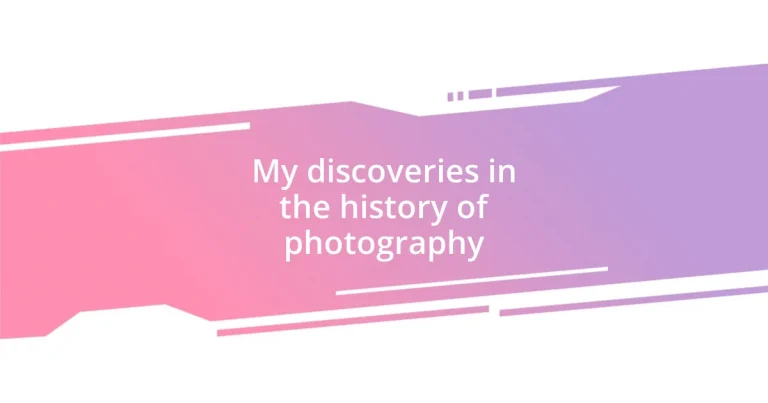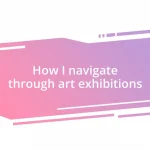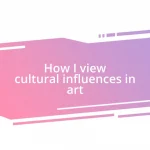Key takeaways:
- The invention of the camera obscura and later, the first permanent photograph by Joseph Nicéphore Niépce marked the foundational moments in the development of photography.
- Louis Daguerre’s introduction of the daguerreotype in 1839 and George Eastman’s roll film in 1888 significantly advanced photographic technology, making it more accessible to the public.
- The evolution of photography continued with notable movements like Pictorialism, Modernism, and Street Photography, each influencing the artistic expression and societal reflections captured through the lens.
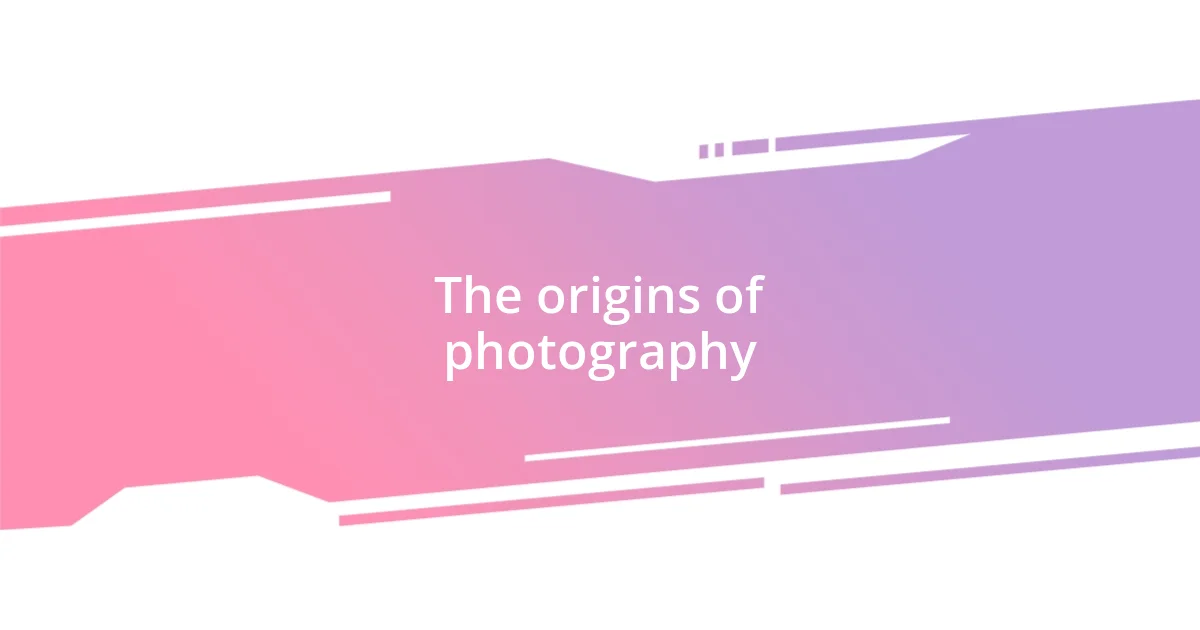
The origins of photography
When I first delved into the origins of photography, I was fascinated to learn that the idea dates back to ancient times, with the camera obscura, a device that projected images through a small hole, being a precursor to our modern cameras. Imagine a dark room with just a tiny opening allowing light to cast an image of the outside world onto a surface—the very essence of what photography would become was already taking shape!
It’s incredible to think that in the early 19th century, pioneers like Joseph Nicéphore Niépce captured the first permanent photograph using a process called bitumen of Judea on a pewter plate. It’s striking to realize how painstaking those early processes were; Niépce’s first successful image took a whopping eight hours to expose! Can you imagine waiting that long just to see the results? It really makes me appreciate the instant gratification of digital photography today.
As I reflected on these historical moments, I couldn’t help but feel a sense of awe towards the early innovators who dared to explore this uncharted territory. Their passion and relentless experimentation laid the groundwork for what would soon evolve into an art form, a means of communication, and a way to capture memories. It makes me wonder: how many of us truly understand the depth of emotion and effort behind the seemingly simple act of taking a photograph today?
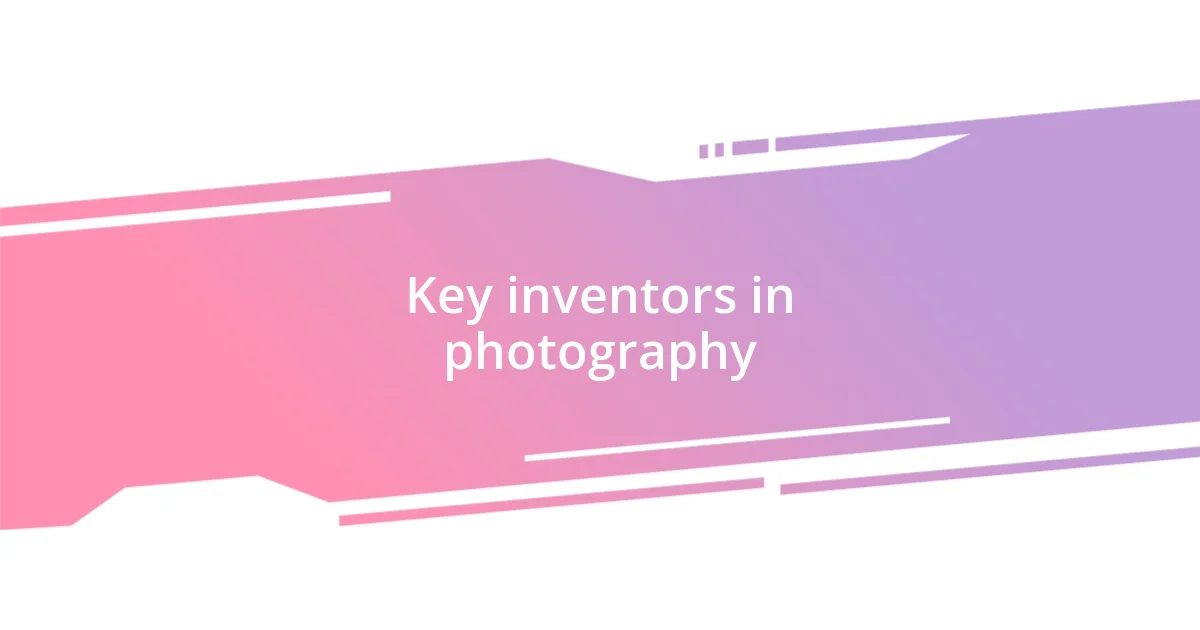
Key inventors in photography
The field of photography has been shaped significantly by several innovative minds throughout history. One of the most pivotal figures is Louis Daguerre, who introduced the daguerreotype process in 1839. I find it astonishing how this method not only reduced exposure time to around 30 minutes but also produced stunningly detailed images that captivated the public. It’s like he unlocked a door that had been closed for centuries, inviting more people to experience the magic of photography.
Another key inventor was George Eastman, the founder of Kodak, who revolutionized photography with the introduction of roll film and the Kodak camera in 1888. This made photography accessible to the masses, and as I reminisce on my childhood, I’m reminded of my first disposable camera. It felt empowering to capture moments without needing to know the intricate details of the technology behind it. Eastman’s vision to give everyone the ability to take pictures has undoubtedly transformed how we document our lives.
Then, there’s the contribution of Alfred Stieglitz, who not only helped establish photography as an art form but also created the gallery 291 in New York City. I remember visiting art galleries, feeling a sense of connection to the emotions portrayed through the lens of gifted photographers. Stieglitz’s work encouraged many to view photography not just as a tool for documentation but as a medium for artistic expression. His legacy prompts me to ask: how do we elevate our own photographs to tell deeper stories?
| Inventor | Contribution |
|---|---|
| Joseph Nicéphore Niépce | First permanent photograph (bitumen of Judea) |
| Louis Daguerre | Introduced daguerreotype, reducing exposure time |
| George Eastman | Created Kodak camera and roll film, making photography accessible |
| Alfred Stieglitz | Established photography as an art form through gallery 291 |
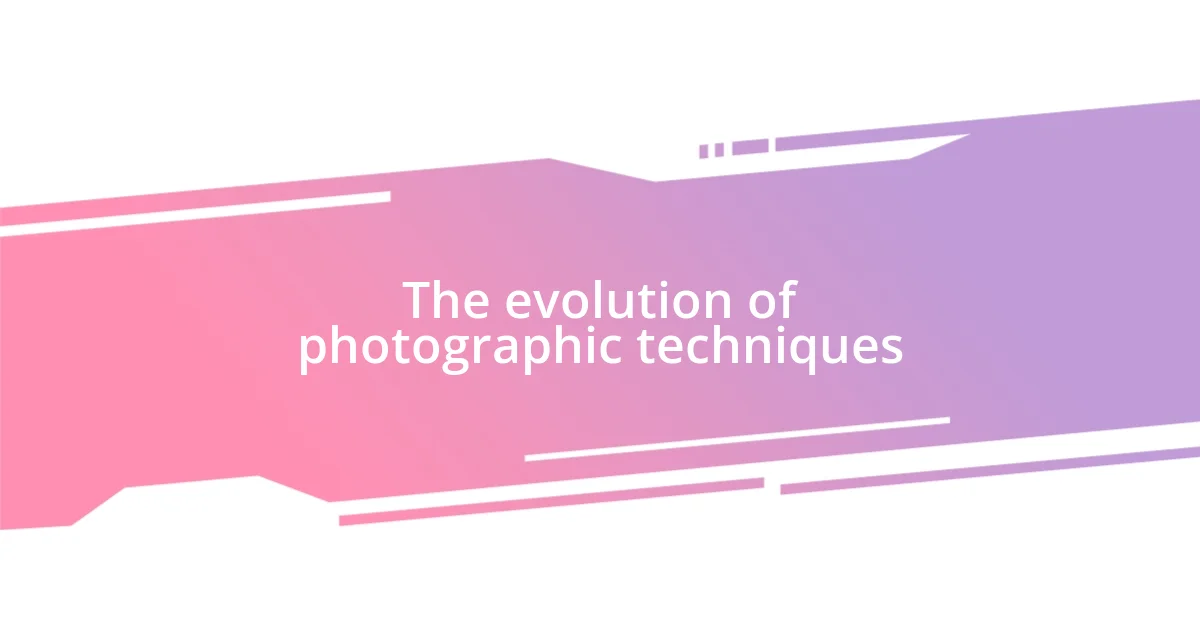
The evolution of photographic techniques
The evolution of photographic techniques is a captivating journey full of trial and error, innovation, and inspiration. I remember flipping through old family albums and admiring the grainy, sepia-toned photographs from my grandparents’ time. Those images may seem distant, but they showcase the significant strides photography has made since its inception. From the long exposure times of the early daguerreotypes to today’s instant digital snaps, the transformation is nothing short of remarkable.
- The introduction of flexible roll film by George Eastman in 1888 allowed for more spontaneous photography; I can’t help but smile remembering the joyous chaos my friends and I captured during our youth with a film camera in tow.
- Later, the Polaroid camera brought the thrill of instant prints, like unwrapping a small gift with every click, a concept that resonated with that childlike excitement we often take for granted.
- With the rise of digital photography, a whole new realm of techniques emerged. I still vividly recall my first digital camera; it felt like I had a limitless canvas to express myself, plunging into an entirely new way of storytelling through images.
These milestones in photographic techniques reflect not only technical advancements but also the emotional connections we create through captured moments.
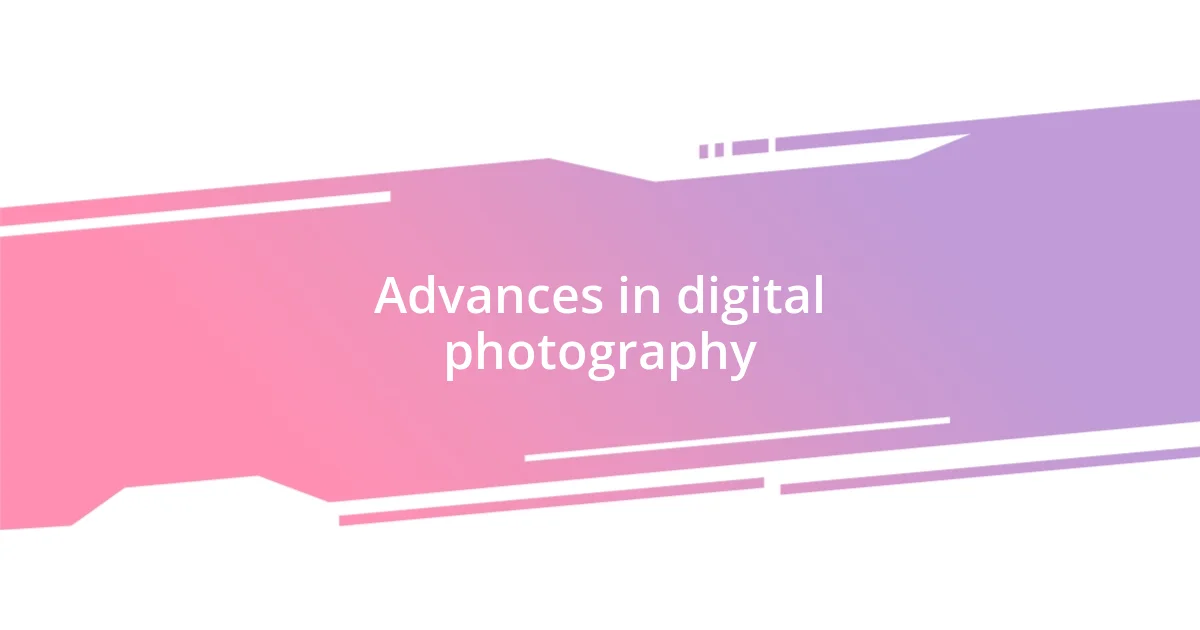
Advances in digital photography
Digital photography has dramatically transformed the way we capture and share moments. One of the biggest advancements has been the development of high-resolution image sensors. I remember unboxing my first digital DSLR and feeling a surge of excitement as I realized I could take crisp, vibrant photos that were previously only possible with expensive professional equipment. It’s amazing how this technology allows not just professionals but anyone with a camera to capture stunning images, making photography feel more inclusive than ever.
Another significant milestone came with the introduction of image editing software. I still recall sitting for hours at my computer, editing photos from a recent trip, experimenting with different filters and adjustments. This creative freedom has completely altered the landscape of photography. It pushes me to wonder: how does post-processing contribute to the storytelling aspect of our images? We now have the power to enhance our narratives through editing tools, allowing us to evoke emotions and convey messages that might have otherwise been lost.
The rise of social media platforms dedicated to photography has also been pivotal. It feels like a digital gallery where every photo can be instantly shared and critiqued. I vividly remember getting feedback on my pictures from friends and strangers alike, which boosted my confidence and inspired me to improve my craft. This immediacy not only connects us to a larger community but also raises the bar for quality. Are we creating just for ourselves, or are we also crafting images with our audience in mind? This interplay constantly shapes our approach to photography, making the experience even more dynamic and collaborative.
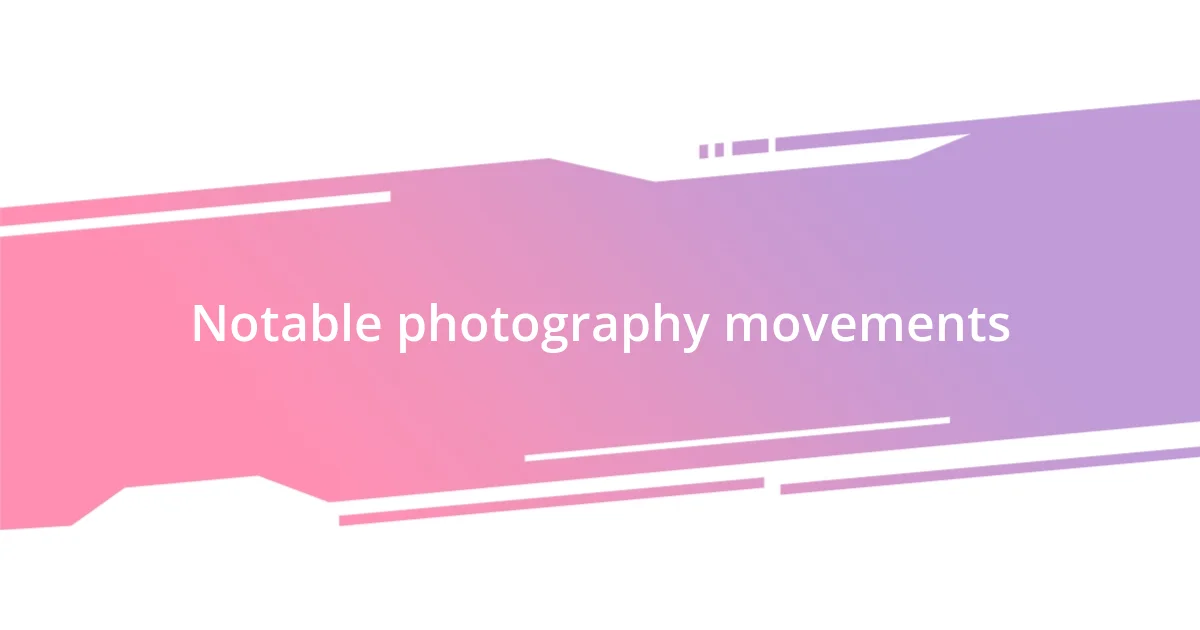
Notable photography movements
The evolution of photography has been punctuated by notable movements that have shaped its artistic direction. For instance, the Pictorialism movement in the late 19th century focused on creating soft, artistic images that conveyed emotion, rather than just straightforward documentation. I recall experimenting with soft focus techniques in college, trying to recreate that same ethereal quality, which was both challenging and rewarding. Have you ever tried to capture a feeling instead of just a subject? It’s a different mindset that invites creativity.
Then came Modernism, which broke away from traditional approaches and embraced experimentation. I remember being struck by the stark compositions of photographers like Edward Weston, who found beauty in the mundane through graphic shapes. This made me ponder the question: can the ordinary become extraordinary simply through our perspective? That movement taught me that what I choose to frame is just as essential as what I leave out, shifting the focus to the viewer’s experience.
The more recent movement of Street Photography has also profoundly influenced the genre. Capturing candid moments in public places has a unique thrill—like a treasure hunt for authentic human experience. I often reflect on how shooting in bustling urban environments allows me to witness untold stories unfold, making each click a moment in history. Have you ever captured something unexpected while wandering through your city? The spontaneity of street photography never fails to remind me of the richness of life happening right around us, if only we take a moment to notice.
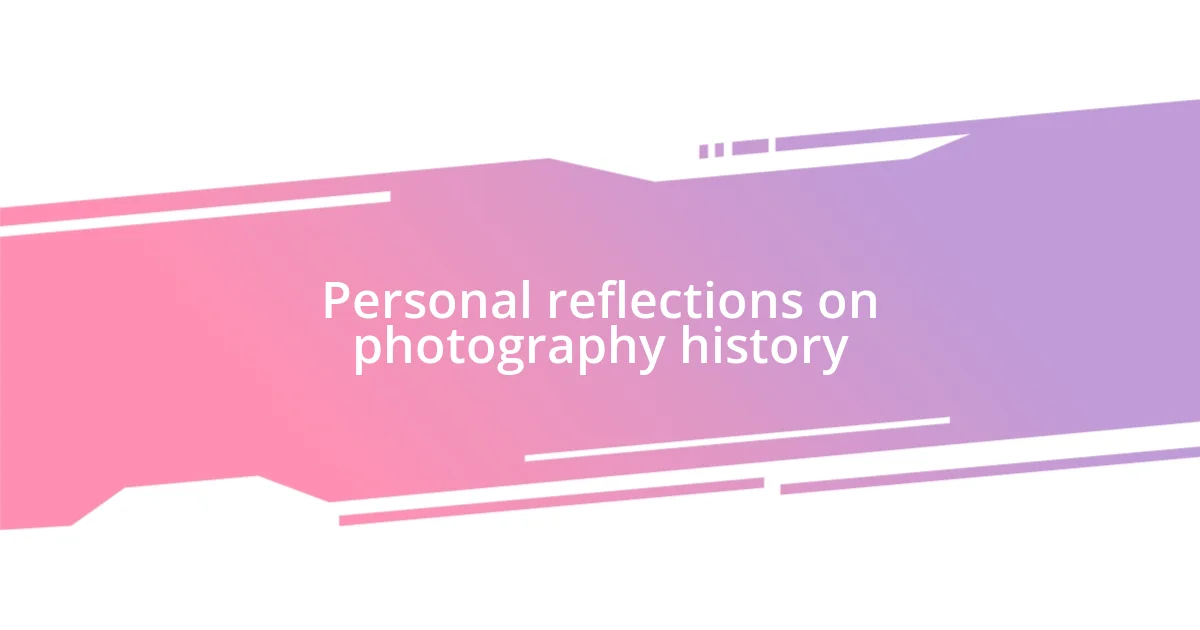
Personal reflections on photography history
Reflecting on photography’s history, I often think about how each technological advancement has deeply affected my relationship with the medium. I can still remember holding a film camera for the first time, that nostalgic click of the shutter making me feel like I was capturing pieces of time. It seemed so magical in those moments to know that I was stepping into a realm that artists had explored for decades, and I wondered how past photographers felt, waiting for their images to develop in dark rooms filled with chemistry and anticipation.
When I stumbled upon the works of early photographers, especially those who documented the harsh realities of life, it struck a chord within me. Their boldness to reveal the world through their lens made me question my own subject choices. I still feel a mix of inspiration and responsibility—how can I use my photography to tell the stories that matter? It’s a powerful reminder that photography is not just about capturing what is beautiful but also about illuminating the unseen and giving voice to the stories that might otherwise remain untold.
Moreover, as I sift through the evolution of photographic styles, I find myself drawn to the way each era expresses societal values and challenges. For instance, the shift from posed portraits to candid shots makes me think about how we view authenticity today. Isn’t it fascinating how the rawness of a snapshot can provoke a strong emotional response? Whenever I capture an unguarded moment, I feel like I’m bridging the gap between the past and present, echoing the emotions and struggles experienced by others before me. Each click of the camera seems to connect the stories of those who came before us, unfolding in beautiful continuity.












